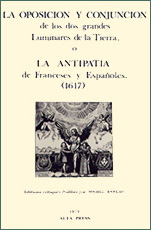
Scholarly Works


La oposición y conjunción de los dos grandes luminares de la Tierra o Antipatía de los Franceses y Españoles.
L'opposition et conjonction des deux grands luminaires de la Terre ou Antipathie des Français et des Espagnols.
Éditions critiques du traité polémique du Dr. Carlos García publié à Paris en 1617, en français et en espagnol, établies par Michel L. Bareau, University of Alberta.
ISBN: 0-921984-00-6
Édition cartonnée, Hard cover, 16 x 25,5 cm, 1978, Pl. XX, pp. 401. €.54,00.
La Antipatía, with its simultaneous presentation of the original French and Spanish texts of 1617, gives us an insight into the collective consciousness of the period via its incisive analysis of the dense network of polemical metaphors concerning the Spanish Marriage of 1614. The ample iconography and in-depth analysis of the psychology grounding the satire leveled against the Spanish brings to the fore those stereotypes which have come to be associated with the French and Spanish nations. Whilst including a biographical sketch of the author, as well as an outline of the influence and fortunes of La Antipatía, Bareau's work focusses more particularly on a socio-historical and linguistic analysis of the structural metaphors underlying the collective consciousness of the period. Funded by the Social Sciences and Humanities Research Council of Canada, Bareau's illustrated critical edition of the original French and Spanish texts of Dr. Carlos García (first published in Paris in 1617) is intended for literary critics, historians and linguistic scholars.
Cette double édition critique est précédée d'une analyse des métaphores structurales et reconstitue une partie des réseaux métaphoriques qui hantent la conscience polémique collective de la période considérée. Une suite iconographique et une ample documentation sur les thèmes et les mythes de la satire anti-espagnole de l'époque mettent en valeur le conditionnement psychologique et les stéréotypes qui président encore aujourd'hui à la réception de la pensée espagnole à l'étranger. Lié aux Mariages franco-espagnols, cet ouvrage impose, dès 1614, la reconnaissance du mythe solaire royal, et ouvre d'intéressantes perspectives sur l'utilisation des thèmes picaresques dans la polémique au service de Marie de Médicis, et dans le roman français du XVIIe siècle. Ce traité peut être considéré comme un premier essai structuraliste sur les mentalités, inscrit dans les structures théologiques de la Contre-Réforme.
L'opposition et conjonction des deux grands luminaires de la Terre ou Antipathie des Français et des Espagnols.
Éditions critiques du traité polémique du Dr. Carlos García publié à Paris en 1617, en français et en espagnol, établies par Michel L. Bareau, University of Alberta.
ISBN: 0-921984-00-6
Édition cartonnée, Hard cover, 16 x 25,5 cm, 1978, Pl. XX, pp. 401. €.54,00.
La Antipatía, with its simultaneous presentation of the original French and Spanish texts of 1617, gives us an insight into the collective consciousness of the period via its incisive analysis of the dense network of polemical metaphors concerning the Spanish Marriage of 1614. The ample iconography and in-depth analysis of the psychology grounding the satire leveled against the Spanish brings to the fore those stereotypes which have come to be associated with the French and Spanish nations. Whilst including a biographical sketch of the author, as well as an outline of the influence and fortunes of La Antipatía, Bareau's work focusses more particularly on a socio-historical and linguistic analysis of the structural metaphors underlying the collective consciousness of the period. Funded by the Social Sciences and Humanities Research Council of Canada, Bareau's illustrated critical edition of the original French and Spanish texts of Dr. Carlos García (first published in Paris in 1617) is intended for literary critics, historians and linguistic scholars.
Cette double édition critique est précédée d'une analyse des métaphores structurales et reconstitue une partie des réseaux métaphoriques qui hantent la conscience polémique collective de la période considérée. Une suite iconographique et une ample documentation sur les thèmes et les mythes de la satire anti-espagnole de l'époque mettent en valeur le conditionnement psychologique et les stéréotypes qui président encore aujourd'hui à la réception de la pensée espagnole à l'étranger. Lié aux Mariages franco-espagnols, cet ouvrage impose, dès 1614, la reconnaissance du mythe solaire royal, et ouvre d'intéressantes perspectives sur l'utilisation des thèmes picaresques dans la polémique au service de Marie de Médicis, et dans le roman français du XVIIe siècle. Ce traité peut être considéré comme un premier essai structuraliste sur les mentalités, inscrit dans les structures théologiques de la Contre-Réforme.
<< back







